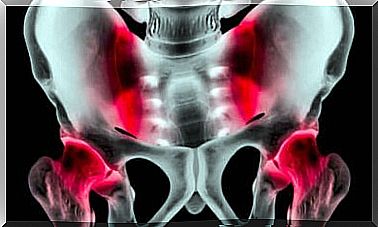Characteristics Of Progressive Ossifying Fibrodysplasia
Progressive Fibrodysplasia Ossifying is a serious and disabling disorder of connective tissue. It is characterized by congenital malformations of the first finger of both feet and progressive ossification of soft tissues: skeletal muscles, tendons, fasciae and ligaments.

Progressive ossifying fibrodysplasia is a dominant genetic pathology, that is, it is caused by the mutation of a gene which is transmitted by at least one of the parents.
It is considered a rare disease because its worldwide prevalence is approximately 2 / 1,000,000. It does not exhibit racial, geographic or gender variations.
Clinical features
Ossification of extraskeletal tissue occurs in flare-ups from childhood. When they are born, babies with this condition have birth defects in the big toe of both feet.
During the first ten years of life, soft tissue transforms into bone, causing a gradual loss of mobility.
The first episodes usually appear in areas near the spine (neck and shoulders) and spread to other joints and muscle groups (hip, elbows and knees). They are frequently triggered by lesions in the tissue in question, intramuscular injections or viral infections.
The pathology progresses gradually and does not affect the smooth tissue. Therefore, it does not affect the functions of the muscles of the face, diaphragm and heart.

Symptoms of progressive ossifying fibrodysplasia
Symptoms of progressive ossifying fibrodysplasia usually begin between the ages of four and six. The course of the disease is variable: there are periods of latency and periods of aggravation. Patients who suffer from this pathology describe the following symptoms:
- Episodes of muscle pain and inflammation that end in tissue ossification.
- Loss of mobility, partial or complete.
- Development of deafness and baldness in a third of cases.
Some patients exhibit these characteristic traits, along with other symptoms that are not usually associated with this disease, such as:
- Recurrent aplastic anemia.
- Infantile glaucoma.
- Delay in growth.
- Craniopharyngioma.
Attacks in progressive ossifying fibrodysplasia
Seizures occur when soft tissue ossification begins. During these periods, patients may have a slight fever and general discomfort, in addition to sharp pain and swelling.
Their duration varies depending on the amount of tissue that turns into bone, although they usually last from seven to nine weeks.
The majority of those affected are relieved after the seizure ends, which suggests that the pain is due to the formation of bone and not to the new tissue being formed.
Diagnostic
The diagnosis of progressive ossifying fibrodysplasia is made by clinical evaluation. X-ray techniques can confirm more subtle abnormalities in concrete areas, but genetic testing confirms the diagnosis.
It is important to make a good differential diagnosis so as not to confuse this pathology with another with similar characteristics, such as progressive bone heteroplasia, lymphedema, osteosarcoma, soft tissue sarcoma or acquired heterotopic ossification.
Treatment of progressive ossifying fibrodysplasia
There is currently no definitive treatment for this disease. However, affected patients must follow a series of preventive standards and adequate pharmacological treatment to alleviate the pain.
In seizures, high doses of drugs are usually prescribed with corticosteroids for periods of four days, starting within 24 hours of the onset of the episode to reduce the inflammation and tissue edema characteristic of these phases.
It is recommended to avoid any trauma to the muscle through the application of preventive measures against falls and knocks: improvement of the safety of the home, use of special protections to carry out physical activities, etc.
Physiotherapy can help reduce the patient’s pain, but it should be gentle and always performed by a healthcare professional. Cryotherapy may also be used to relieve the pain of attacks.
Surgical interventions and intramuscular injections should only be done in cases of extreme necessity.

Prognosis
The average life expectancy is around 50 years. The majority of patients lose mobility during their second decade of life and die from complications of thoracic insufficiency syndrome.
Currently, the search for treatments for progressive ossifying fibrodysplasia aims to delay tissue ossification. Clinical trials with drugs are underway; these drugs, used as an infusion at the onset of seizures, may inhibit soft tissue calcification.









